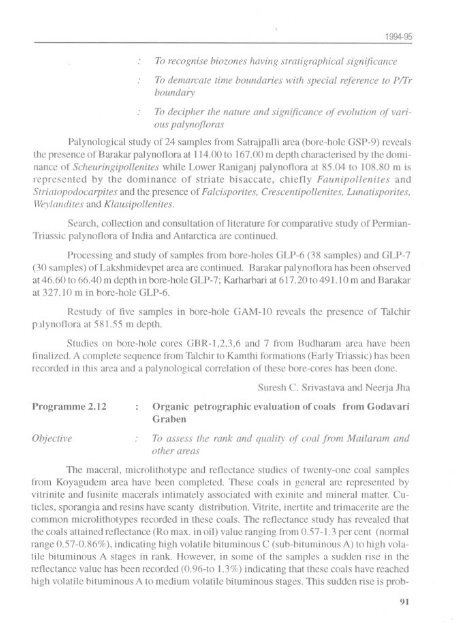1994-95 - Birbal Sahni Institute of Palaeobotany
1994-95 - Birbal Sahni Institute of Palaeobotany
1994-95 - Birbal Sahni Institute of Palaeobotany
Create successful ePaper yourself
Turn your PDF publications into a flip-book with our unique Google optimized e-Paper software.
<strong>1994</strong>-<strong>95</strong><br />
To recognise biozones having sTraTigraphical significance<br />
To demarcaTe time boundaries<br />
boundary<br />
wiTh special reference to PlTr<br />
To decipher the naTure and significance <strong>of</strong> evolwion <strong>of</strong> various<br />
palyn<strong>of</strong>loras<br />
Palynological study 0[24 samples [rom Satrajpalli area (bore-hole GSP-9) reveals<br />
the presence <strong>of</strong> Barakar palyn<strong>of</strong>lora at 114.00 to 167.00 m depth characterised by the dominance<br />
o[ Schellringipollenites while Lower Raniganj palyn<strong>of</strong>lora at 85.04 to 108.80 m is<br />
represented by the domi nance o[ striate bisaccate, chiefly Fallnipollenites and<br />
STriatopodocarpites and the presence o[ Falcisporites, CrescenTipollenites, LWIOTisporites,<br />
Wevlandites and Klallsipollenites.<br />
Search, collection and consultation o[ literature [or comparative study o[ Permian<br />
Triassic palyn<strong>of</strong>lora o[ India and Antarctica arc continued.<br />
Processing and study <strong>of</strong> samples from bore-holes GLP-6 (38 samples) and GLP-7<br />
(30 samples) <strong>of</strong> Lakshmidevpet area arc continued. Barakar palyn<strong>of</strong>lora has been observed<br />
at46.60 to 66.40 m depth in bore-hole GLP-7; Karharbari at 617.20 to 491.1 Om and Barakar<br />
at 327.10 m in bore-hole GLP-6.<br />
Restudy <strong>of</strong> five samples in bore-hole GAM- I0 reveals the presence o[ Talchir<br />
p.llyn<strong>of</strong>lora at 58 I.55 m depth.<br />
Studies on hore-hole cores GBR-l,2,3,6 and 7 from Budharam area have been<br />
linalized. A complete sequence f1"OmTalchir to Kamthi formations (Early Triassic) has heen<br />
recorded in this area and a palynological correlation <strong>of</strong> these hore-cores has been done.<br />
Suresh C. Srivastava and Neerja Jha<br />
Programme 2.12<br />
Objective<br />
Organic petrographic evaluation <strong>of</strong> coals from Godavari<br />
Graben<br />
To assess the rank and quality <strong>of</strong> coal from Mailaram and<br />
other areas<br />
The maceral, microtithotype and reflectance studies o[ twenty-one coal samples<br />
[rom Koyagudem area have been completed. These coals in general are represented by<br />
vitrinite and fusinite macerals intimately associated with exinite and mineral matter. Cuticles,<br />
sporangia and resins have scanty distribution. Vitrite, ineliite and trimacerite are the<br />
common microlithotypes recorded in these coals. The reflectance study has revealed that<br />
the coals attained refleetance (Ro max. in oil) value ranging [rom 0.57- I. 3 per cent (normal<br />
range 0.57-0.86%), indicating high volatile bituminous C (sub-hituminous A) to high volatile<br />
bituminous A stages in rank. However, in some <strong>of</strong> the samples a sudden rise in the<br />
reflectance value has been recorded (0.96-to 1.3%) indicating that these coals have reached<br />
high volatile hituminous A to medium volatile bituminous stages. This sudden rise is proh-<br />
91

















